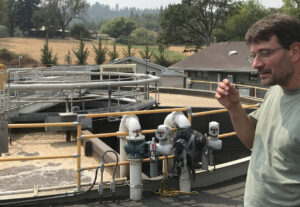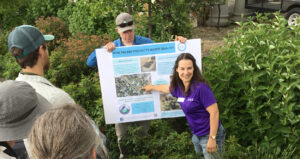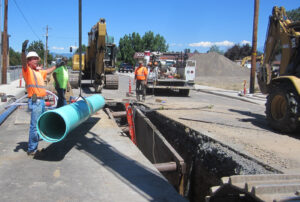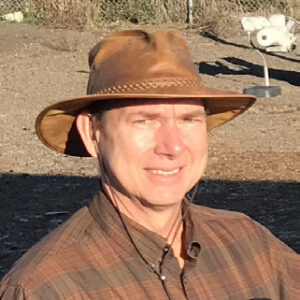Rogue Valley Sewer Services (RVSS), based in Central Point, Oregon, is a sewer and storm water service provider for eight Oregon cities. It is remarkable for its affordable fees, its focus on innovation, and its management of programs like public outreach, pollution prevention, water quality, and permitting. Its program management, in particular, gained it a Municipal Stormwater and Green Infrastructure Award from the Water Environment Federation (WEF).
In this interview, RVSS General Manager Carl Tappert speaks with Municipal Water Leader about his agency’s history and services, its recent award, and his vision for the future.

Municipal Water Leader: Please tell us about your background and how you came to be in your current position.
Carl Tappert: I’m a civil engineer by training with a bachelor’s degree from West Virginia University. After I graduated, I spent 3 years in Malawi as a Peace Corps volunteer, came back, moved to Oregon, and spent 5 years working for a private consulting firm. Later, I started working for the district as a district engineer, and in 2011, the former manager retired and I moved into his position.
Municipal Water Leader: Please tell us about RVSS and its history.
Carl Tappert: RVSS is a special district and was formed in 1966. There was an election to create it. Our initial charge was to build a sewer interceptor that would connect four different cities’ sewer systems to a regional treatment plant. Those four cities were Medford, which operates the treatment plant; Central Point; Phoenix; and Talent, Oregon. Over the years, the area grew, and the collection system expanded with it. Eventually, the cities decided that they wanted to get out of the sewer business and held annexation votes with the result that their collection systems became part of our district. The exception is Medford, which still has its own collection system and operates the treatment plant into which everyone’s waste flows.
As it stands right now, eight different cities are part of our system. Six of them are connected to the regional treatment plant, and we operate all their collection systems. We recently annexed Shady Cove, which has an independent treatment plant that we operate. The last one is Gold Hill, whose system we operate under contract, though it’s not part of our district.
In addition to our sewer services, we became involved with storm water in 1989. There was an unincorporated industrial region in our districts that was having a lot of flooding issues. Because it wasn’t part of any city, property owners chose to form a utility to manage its flood problems. An election was held, and RVSS became the operator of the storm drainage utility in the area.

In 2004, the Municipal Separate Storm Sewer System (MS4) Phase 2 permit requirements came into effect in Oregon. The larger cities adjacent to RVSS’s service area, Medford and Ashland, as well as smaller areas surrounding them, were required to obtain MS4 Phase 2 permits from the Oregon Department of Environmental Quality. The smaller cities did not have the resources or expertise to implement the MS4 permit. These smaller cities were all located within RVSS’s district boundary and requested that RVSS serve as the permit holder. As an existing regional entity, RVSS had the staff and resources needed to implement a regional MS4 program and reached an agreement with the small communities. We have been the permit holder for the cities of Phoenix and Talent and for Jackson County since 2004. Up until this year, RVSS also held the permit for Central Point.
Municipal Water Leader: Are your sewer and storm water systems separate?
Carl Tappert: We don’t have any combined sewers. The sanitary sewer and storm water systems are completely separate.
Municipal Water Leader: Would you give us a sense of the total amount of infrastructure you have?
Carl Tappert: On the sanitary sewer side, we’ve got about 440 miles of underground pipe and 26 pump stations, which serve a population of about 95,000. For wastewater treatment, we operate two small activated sludge plants for the cities of Shady Cove and Gold Hill, which together have a capacity of about 500,000 gallons per day. Those two plants serve a population of about 5,000. We also have an old facultative lagoon that we use for treating hauled waste, septic waste, and grease trap waste. That treats about 2 million gallons a year. On the storm water side, we manage the storm water collection infrastructure for one small industrial area with about 230–260 industrial properties. There are about 7 miles of storm water pipe in the ground. As for storm water quality, that’s more a regulatory process than it is infrastructure, but we manage the MS4 permit program for an area of about 30 square miles with around 21,000 accounts. We do maintain 45 storm water quality facilities.
Municipal Water Leader: How much of that infrastructure goes all the way back to 1966?
Carl Tappert: Not much of it. When we were formed, the cities in existence didn’t have much. They had sewers in place, but most of that has since been replaced. None of the storm water infrastructure existed yet. Our collection system has an average age of about 35 years.
Municipal Water Leader: Is RVSS primarily funded by service fees?
Carl Tappert: Yes, almost exclusively.
Municipal Water Leader: How do you work to keep those fees affordable?
Carl Tappert: Our residential sewer rate is $21.50 a month, which is pretty close to the lowest rate you’re going to find in the state of Oregon. We have achieved that without shortchanging ourselves. There are a couple of things that contribute to it. One is that we’re a regional facility—we’re relatively big and benefit from economies of scale. Our treatment costs are pretty low because we have a big regional plant, and our collection costs are pretty good because of our size. Another thing that I think contributes to our affordable fees is our aggressive approach to our capital, improvement, and rehabilitation programs. We dedicate about a quarter of our revenue to rehabilitation work, which we generally design in house. Keeping on top of rehabilitation keeps our operation costs low. Relative to the amount of infrastructure that we maintain, we operate on a pretty lean staff. We have also been willing to make investments to improve our efficiency. We have focused a lot on energy savings. Recently, we installed solar power at our main office and our largest pump station to improve our resiliency and keep our operating costs down.

Another factor contributing to our success is an incredibly stable board of directors. Over 53 years, our directors have had an average tenure of about 9 years on the board, which is pretty good for elected volunteer positions. We have a lot of institutional knowledge and a lot of support from our board of directors to do what’s right. That enables us to keep our rates low and still maintain the facilities at a high level.
Municipal Water Leader: Earlier this year, you were awarded WEF’s Municipal Stormwater and Green Infrastructure Award. Would you tell us about the award and what WEF was recognizing you for?
Carl Tappert: We were awarded for our program management. I think WEF looked at our services in totality. We were also categorized at the silver level for innovation. When the MS4 Phase 2 regulations came out, our approach was to embrace them. We have focused on achieving improvements in water quality rather than simply meeting the minimum requirements of the permit. The requirements establish six minimum control measures: public education and outreach, public involvement, illicit discharge detection and elimination, construction site runoff control, postconstruction runoff control, and pollution prevention and good housekeeping for municipal operations. We’ve really pushed hard on each of those and have taken a leadership role in the community on many of them. A lot of things that will soon be required, such as monitoring outfalls, are things we’ve been doing for years. If you’re going to try to reduce pollution, you have to see where it’s coming from. That’s proven to be an effective approach.
Maintaining relationships and communications between the communities we serve and regional collaborators has been critical to our success. RVSS is a key player in several regional initiatives, including Stream Smart, a collaborative effort to develop and implement a water quality messaging and marketing campaign, and the Salmon Watch program, which provides students with a field trip to a local waterway where they have direct contact with wild salmon and learn how water quality affects salmon survival.
Early on, we stepped up and took over the management of the construction site storm water discharge permit program for activities within our MS4 boundary. As an agent for the state, we can provide monitoring and supervision of these construction sites and at the same time be more responsive to the development community through faster permit application turnaround.
Postconstruction runoff control refers to permanent storm water quality facilities that are built as part of development or redevelopment activities. We developed a storm water design manual that guides the design, installation, and maintenance of storm water facilities, not just for RVSS, but for the other MS4 permit holders in the Rogue Valley as well. We lead a regional working group consisting of a variety of stakeholders that meets to discuss changes needed to the design manual to meet new permit requirements.
In total, our storm water program has aimed at improving water quality beyond what we need to do merely to satisfy our permit requirements. I think that’s what the folks at WEF recognized with the award.
Municipal Water Leader: What personnel issues do you have at RVSS?
Carl Tappert: It’s becoming more and more difficult to find trained, certified operators, particularly on the treatment side. Especially in smaller communities, not a lot of people have the required level of certification. That’s one of the reasons we operate the treatment plants of two cities. They had retirements and couldn’t hire certified operators. These smaller communities are often able to get some level of grant and loan funding to build sophisticated treatment plans, but they are not able to retain the skilled operators needed to keep them running. As a regional entity, RVSS is able to attract and retain skilled operators. I see the shortage of operators as a big issue statewide and nationally.
Municipal Water Leader: What are your priorities for 2020?
Carl Tappert: Our big issue with infrastructure is improving our efficiency. We’re at a point where we don’t have any significant capacity deficiencies within our collection system. We’re now focused on trying to make everything operate better. We’re doing some upgrades on our flow monitoring capabilities, with the idea that we’ll be able to use that information to better target our rehabilitation work. It’ll also identify some of the weaknesses in the system. On the treatment side, we’re looking at the beneficial reuse of our biosolids, although we need to address some concerns about contaminants before we jump into that. As for stormwater, we were just issued our new MS4 Phase 2 permit, which includes a lot of new requirements, most of which we’re already addressing. The regulatory climate is always something we have to watch closely to see what’s coming at us.
Municipal Water Leader: What is your vision for the future?
Carl Tappert: Our official vision statement is that River Valley Sewer Services strives to be the best run, best managed, and most capable sanitary and storm sewer provider in the state and to use its abilities to improve water quality and quality of life throughout the region. We’re there in a lot of ways, and WEF award for our storm water program recognizes that. Our two biggest efforts right now are to improve our transfer of information and to improve our efficiency. We’re making a big push to integrate our various databases and information into geographic information systems so that our crews in the field have those maps on their tablets and can track and monitor the maintenance that they’re doing on each section of pipe as they do it. The better we track and manage the data, the better the decisions we can make regarding capital investments.
Wastewater treatment and vehicle fuel are our largest uses of energy. We are always looking to improve our efficiency. Over the past few years, we have installed solar power systems; commissioned alternative fuel vehicles, both propane and electric; installed high-efficiency equipment; and attacked pumping costs by targeting rehabilitation projects to reduce infiltration and inflow. What we have seen and hope to continue to see is a steady reduction in the amount of energy needed to operate the system.
Carl Tappert is general manager of Rogue Valley Sewer Services. He can be contacted at info@rvss.us. For more information, visit www.rvss.us. 
